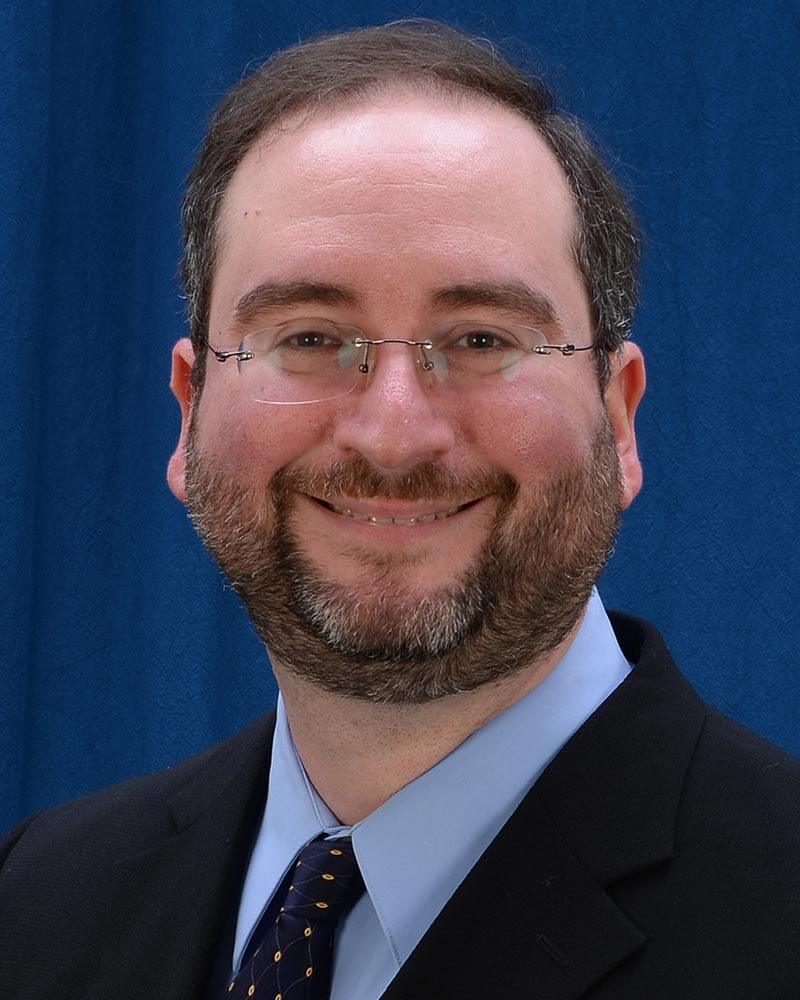Professional Development Courses
In-Person Courses
Raleigh Convention Center—Raleigh, North Carolina, October 24-26
(in-person courses are in Eastern Standard Time)
Basic Level Courses
For those new to the profession or would like training in a particular topic.
Friday, October 24, 2025, 8:00 AM – 5:00 PM
1. BSL-3 Operations and Management
This course will review the important aspects of BSL-3 Operations and Management from two points of view; “hardware” (i.e., facilities & equipment issues) and “software” (i.e., administrative controls). It will cover various aspects you need to consider in order to operate a BSL-3 facility, such as training, maintenance support, occupational health, waste management, maintenance, performance verification, and emergency response. The instructors will encourage interaction and the exchange of experiences among the attendees. Regulatory aspects from any specific country, or planning, design, or construction-related issues will not be covered.
Objectives:
- Describe the elements of BSL-3 Operations and Management (risk management, primary barriers, annual performance verification, emergency response, etc)
- Recognize institutional, management, and user responsibilities
- Summarize approaches to developing manuals, SOPs, and training
Suggested Background: Basic Risk Assessment and familiarity with BSL-3 Concepts
Target Audience: Safety Professionals, BSL-3 Managers, Containment Engineers, Lab and Scientific Directors
Audience Level: Basic
COURSE FACULTY
CONTACT HOURS
This course has been approved for 1.0 CM points toward RBP/CBSP recertification. ABSA International is approved as a provider of continuing education programs in the clinical laboratory sciences by the ASCLS P.A.C.E.® Program. This course is approved for 7.5 P.A.C.E.® contact hours.
Friday, October 24, 2025, 8:00 AM – 5:00 PM
4. Intersection of Biological Safety and the Clinical Environment
Clinical environments present unique challenges, including fast-paced patient care, exposure to unkown biological agents, and high-risk procdures like autopsies and HAZMAT responses. These settings are regulated by accreditation bodies such as the Joint Commission (TJC), College of American Pathologists (CAP), and the Clinical Laboratory Improvement Amendments (CLIA) for accreditation of their spaces, personnel, work practices, and most importantly safety. At large academic teaching hospitals, the Biological Safety Office often collaboratores with groups like Infection Prevention, Hospital Epidemiology, Fire and Life Safety, Engineering and Operations, Clinical Engineering, and Emergency Response to ensure compliance. These challenges require a holistic, risk-assessment based, coordinated response and increasingly the biosafety professional is called upon to play a key role in the clinical environment. This course will provide an overview of various clinical environments—inpatient units, primary and specialty care clinics, and clinical laboratories, including BSL-3—highlighting their specific risks and strategies for effective collaboration with other safety groups to mitigate the risks. This course combines interactive case studies and real-life scenarios to engage adult learners in group exercises focused on clinical risk assessment. Attendees will practice identifying and mitigating risks specific to various clinical environments. Through these exercises, attendees will gain a deeper understanding of the collaborative roles of safety groups and develop the skills needed to lead clinical teams toward a state of readiness and accreditation compliance.
Objectives:
- Describe the various clinical environments and how they differ from a traditional research environment
- Develop a working knowledge of collaborate with the various safety groups within the clinical environment
- Perform risk assessments using case studies to determine appropriate biosafety actions in clinical environments
Suggested Background: Fundamentals of Biosafety, Principles and Practices of Biosafety® (PPB), Risk Assessment
Target Audience: All Safety Professionals, All Biosafety Professionals
Audience Level: Intermediate
COURSE FACULTY
CONTACT HOURS
This course has been approved for 1.0 CM points toward RBP/CBSP recertification. ABSA International is approved as a provider of continuing education programs in the clinical laboratory sciences by the ASCLS P.A.C.E.® Program. This course is approved for 7.5 P.A.C.E.® contact hours.
Saturday, October 25, 2025, 8:00 AM – 5:00 PM
5. Facilities Fundamentals for Biosafety Professionals
This course is aimed at strengthening biosafety professionals knowledge of how facility operations support overall biocontainment operations. Through a mixture of presentations from experts in the field and interactive exercises, attendees will reinforce their knowledge of facility system function and their roles in facility design, construction, and operation. The target audience for the course is biosafety professionals who come with backgrounds other than facilities, and it is open to both newcomers and seasoned veterans in the field. The first portion of the course will familiarize attendees with the general concepts biosafety-related facility design and their roles in it, along with the fundamentals of HVAC system operation in the context of BSL-2 and BSL-3 facilities. Topics in this portion of the course include: the role of biosafety personnel in biocontainment facility design, renovation, and operations, understanding design drawings and related construction documents, what the relationship is of facility features to biosafety levels, and HVAC components and their function relative to biocontainment. This section will end with the introduction of an interactive exercise on reviewing design drawings. The instructors will lead interactive exercises and discussions of more detailed aspects of containment facilities and their operation, including: specific infrastructure, equipment, and systems related to operation of a biocontainment facility; autoclave function, waste management, associated facility infrastructure; room decontamination in relation to facility components; interactions between facilities and containment equipment; security, operations, and biosafety.
Objectives:
- Restate the roles of biosafety professionals in facility design and operation
- Explain practical approaches for reviewing design documents.
- Describe the function of discrete facility infrastructure, equipment, and systems related to biocontainment facility operations
Suggested Background: Fundamentals of Biosafety, Principles and Practices of Biosafety® (PPB), Risk Assessment
Target Audience: All Biosafety Professionals, All Safety Professionals
Audience Level: Basic
COURSE FACULTY
CONTACT HOURS
This course has been approved for 1.0 CM points toward RBP/CBSP recertification. ABSA International is approved as a provider of continuing education programs in the clinical laboratory sciences by the ASCLS P.A.C.E.® Program. This course is approved for 7.5 P.A.C.E.® contact hours.
Saturday, October 25, 2025, 8:00 AM – 5:00 PM
8. Emergency Planning for Biological Incidents in High-Containment Labs
Planning for emergencies in biocontainment labs is challenging and requires a specialized approach due to the presence of high-consequence pathogens and complex response needs. This course is designed for emergency managers, laboratory personnel, and response teams focusing on preparedness for biological incidents at your facility. Attendees will explore the regulatory requirements outlined in U.S. federal compliance with the Federal Select Agent Program and OSHA guidelines for developing and implementing a comprehensive incident response plan. An efficient and responsive emergency management program closely integrates with biosafety and biosecurity professionals, as well as local emergency management agencies, health departments, and first responders/receivers, to ensure an effective collaborative response. Through hands-on training, attendees will gain practical skills in incident response planning for biocontainment laboratories. Using interactive activities and case studies, participants will learn to conduct risk assessments, develop and implement comprehensive incident response plans, and coordinate effectively with local emergency management agencies. The course emphasizes a systematic planning process—guided by frameworks like FEMA’s 6-step methodology—to help attendees create tailored, compliant, and proactive emergency response strategies. This training enhances both facility preparedness and community safety in the face of biological incidents.
Objectives:
- Identify and prioritize biological risks and hazards in high-containment environments
- Apply structured emergency planning principles to support laboratory leadership decision-making
- Coordinate response efforts with internal stakeholders and external support agencies
Suggested Background: Recommend completion of the web-based course FEMA Independent Study Course IS-230 – Fundamentals of Emergency Management (for familiarization; exam not required)
Target Audience: All Safety Professionals, All Biosafety Professionals, Emergency Management and Health Preparedness Professionals
Audience Level: Intermediate
COURSE FACULTY
CONTACT HOURS
This course has been approved for 1.0 CM points toward RBP/CBSP recertification. ABSA International is approved as a provider of continuing education programs in the clinical laboratory sciences by the ASCLS P.A.C.E.® Program. This course is approved for 7.5 P.A.C.E.® contact hours.
Intermediate Level Courses
For those with basic knowledge or would like to learn more.
Friday, October 24, 2025, 8:00 AM – 5:00 PM
2. Infectious Substance Shipping Certification
This course is appropriate for those who have some experience with infectious substance handling or shipping but may not have been certified within the past three years. The course utilizes several facilitated learning activities. Attendees have opportunities to mark, label, package and complete documentation for a variety of infectious substances shipments (Category A, Category B, Exempt Patient Specimens). This course would be appropriate for those responsible for packaging, marking, labeling shipments of all categories of infectious substances, dry ice and liquid nitrogen. Attendees have both an online exam (score at least 80%) and practical exercises to complete to demonstrate competency. Successful completion of the course will qualify attendees for IATA/DOT certification.
Objectives:
- Demonstrate competency to meet IATA infectious substance shipping certification requirements
- Restate and demonstrate how to properly package, mark/label, document and prepare shipments of category A and B infectious substances and other non-regulated biological materials
- Paraphrase any regulatory changes over the past several years and apply them to meet regulatory re-training requirements
Suggested Background: None
Target Audience: All Safety Professionals, New Biosafety Professionals, Laboratory Workers
Audience Level: Basic
COURSE FACULTY
CONTACT HOURS
This course has been approved for 1.0 CM points toward RBP/CBSP recertification. ABSA International is approved as a provider of continuing education programs in the clinical laboratory sciences by the ASCLS P.A.C.E.® Program. This course is approved for 7.5 P.A.C.E.® contact hours.
Friday, October 24, 2025, 8:00 AM – 5:00 PM
3. Preparing for and Responding to Laboratory Emergencies – Are you prepared?
Biosafety professionals often provide fundamental training for research and healthcare staff to work safely and respond to potential emergencies involving a wide range of biological hazards. Training employees to proactively identify and take appropriate actions to minimize the likelihood and impact of these types of incidents helps to minimize the development of serious and/or irreversible consequences. This course reviews the process for developing an effective emergency response plan, emphasizing the importance of a comprehensive and well-coordinated training program for laboratory staff, institutional incident response team members, and local first responders (e.g., emergency management services, fire, police, emergency dispatchers) when biological hazards are involved. Specific topics to be addressed include: the basic components of a comprehensive institutional emergency response plan; laboratory-specific contingency plans, emphasizing unique considerations for emergencies that involve biological hazards; staff roles and responsibilities during emergencies; communication strategies and protocols during an emergency event; and training and effective preparedness exercises to ensure a coordinated response effort.
Objectives:
- Review key components of the emergency management cycle as it applies to research institutions and laboratories
- Identify the various roles and responsibilities that are critical to an effective response
- Summarize ways to coordinate and communicate effectively with institutional and local authorities during an emergency
Suggested Background: Biosafety and Biosecurity Training Course (BBTC®), Fundamentals of Biosafety
Target Audience: All Safety Professionals, Laboratory Workers, New Biosafety Professionals
Audience Level: Basic
COURSE FACULTY
CONTACT HOURS
This course has been approved for 1.0 CM points toward RBP/CBSP recertification. ABSA International is approved as a provider of continuing education programs in the clinical laboratory sciences by the ASCLS P.A.C.E.® Program. This course is approved for 7.5 P.A.C.E.® contact hours.
Saturday, October 25, 2025, 8:00 AM – 12:00 PM
10. The Big Bright Beautiful World of BSL-2
Ever wondered why handling human blood samples and culturing infectious influenza both require BSL-2 containment? Or the defining characteristics between BSL-2 and BSL-1 or BSL-3? This course transforms biosafety from a checklist into a strategic risk management framework, adaptable to any facility or resource level. We’ll go beyond textbook scenarios, tackling the gray areas of BSL-2 where critical thinking and adaptability are key. Starting with a rapid refresher on core biosafety principles, we’ll explore how to adjust BSL-2 containment ‘levers’ for real-world applications, even in non-ideal or resource-limited labs. This course isn’t just about following rules—it’s about understanding why they exist. Attendees will explore key topics in biosafety, including distinctions and special considerations of BSL-2 and ABSL-2, the critical difference between regulations and recommendations on lab operations, compare global biosafety guidelines with the BMBL, safe handling of RG-3 agents in BSL-2 settings, emerging BSL-2+ practices, and real-world case studies—such as HIV and SARS-CoV-2—through interactive activities. This course empowers new biosafety professionals to move beyond a rigid, one-size-fits-all approach. Attendees will develop the confidence to make informed, customized containment decisions—becoming strategic biosafety leaders in their field.
Objectives:
- Utilize the BMBL as a framework and move beyond a checklist approach and apply adaptive biosafety practices in diverse laboratory settings, including resource-limited or non-ideal facilities
- Explain BSL-2 containment principles and practices and how this relates to “BSL-2+” containment and allows for the handling of Risk Group 3 agents under BSL-2 conditions
- Adapt the foundation necessary to confidently make non-textbook containment recommendations that will meet BSL-2 recommendations and keep researchers safe
Suggested Background: None
Target Audience: New Biosafety Professionals, All Safety Professionals, Animal Caretakers
Audience Level: Basic
COURSE FACULTY
CONTACT HOURS
This course has been approved for 0.5 CM points toward RBP/CBSP recertification. ABSA International is approved as a provider of continuing education programs in the clinical laboratory sciences by the ASCLS P.A.C.E.® Program. This course is approved for 3.5 P.A.C.E.® contact hours.
Saturday, October 25, 2025, 1:00 PM – 5:00 PM
11. Writing Effective Standard Operating Procedures
This course will offer attendees an understanding of key principles for writing effective standard operating procedures (SOPs). An introduction to the importance of SOPs in achieving desirable and consistent outcomes and issues that must be considered in the SOP writing process will be presented. Examples will include some of the most common human behavior considerations such as compliance, behavioral evolution, complaisance, and strategies to address behavioral concerns that may arise. Attendees will engage in guided discussions about the benefits of an effective SOP writing process and the most common mistakes made by the authors of SOPs. The course will take attendees through the process of writing feasible standard operating procedures (SOPs) including SOP evaluation and validation. Through group interactions, attendees will develop examples of SOPs to illustrate effective writing concepts, present their SOPs to the class, and evaluate each other’s SOPs for feasibility. Instructors will guide attendees through the process by providing critical feedback on the SOP writing process as they progress. The goal of this course is to increase attendees’ awareness of issues that arise when writing standard operating procedures and how these issues affect SOP compliance. Furthermore, the course will provide examples of well-written SOPs that contribute to overall SOP compliance at an institution. The course is intended for those who want to be able to lead or aid in the creation of feasible and effective SOPs in order to enhance both biosafety and biosecurity at their institution.
Objectives:
- Summarize the range of issues that must be considered when writing effective standard operating procedures (SOPs), including human behavior
- Identify strategies for writing effective SOPs
- Illustrate how good standard operating procedures (SOPs) work to enhance both biosafety and biosecurity
- Recognize the value of “feasible” and therefore effective standard operating procedure (SOP) in promoting biosafety and biosecurity best practices
Suggested Background: Fundamentals of Biosafety
Target Audience: All Safety Professionals, New Biosafety Professionals, Laboratory Workers, International Attendees
Audience Level: Basic
COURSE FACULTY
CONTACT HOURS
This course has been approved for 0.5 CM points toward RBP/CBSP recertification. ABSA International is approved as a provider of continuing education programs in the clinical laboratory sciences by the ASCLS P.A.C.E.® Program. This course is approved for 3.5 P.A.C.E.® contact hours.
Sunday, October 26, 2025, 8:00 AM – 5:00 PM
13. A Scenario-Based Introduction to Agricultural Biorisk Management
This course will review general concepts and considerations for assessing and managing risks encountered in research programs that involve animals, plants, pathogens, pests, facilities, equipment, and work practices relevant to agriculture. The focus will be on hazard identification, risk assessment (qualitative and quantitative), and the strategic use of mitigation practices designed to minimize risks in a wide range of agricultural research applications. Attendees will have the opportunity to practice these skills, using real-world scenarios that demonstrate some of the unique challenges and hazards routinely encountered in an agricultural environment. Exercises will be highly interactive and guide attendees through the entire biorisk management process. Emphasis will be given to key factors that influence selecting effective biocontainment and biosecurity measures; ensuring worker safety; protecting local and regionally-important agricultural commodities (livestock, poultry, crops); preserving the environment (plants, wildlife, water systems); and maintaining public health.
Objectives:
- Review hazard identification and risk assessment techniques appropriate for an agricultural research environment
- Identify practical control strategies to successfully manage hazards and risks relevant to agriculture
- Restate the need for effective biosecurity when working with high-consequence agricultural pathogens and pests
Suggested Background: BSL-3 Operations and Management, Fundamentals of Biosafety, Principles and Practices of Biosafety® (PPB), Risk Assessment
Target Audience: All Safety Professionals, Animal Caretakers, Experienced Biosafety Professionals
Audience Level: Intermediate
COURSE FACULTY
CONTACT HOURS
This course has been approved for 1.0 CM points toward RBP/CBSP recertification. ABSA International is approved as a provider of continuing education programs in the clinical laboratory sciences by the ASCLS P.A.C.E.® Program. This course is approved for 7.5 P.A.C.E.® contact hours.
Sunday, October 26, 2025, 8:00 AM – 5:00 PM
14. Facility Commissioning and Recommissioning for the BSL-3 Laboratory
The biosafety professional can assist with the start-up or maintenance of laboratory operations in support of their biosafety programs by understanding the commissioning and recommissioning processes. Laboratory commissioning, identified in containment guidance documents, is a quality assurance process for the effective functioning of biocontainment laboratories. The biosafety officer and other decision makers benefit by having a basic understanding of the commissioning and recommissioning processes and resulting documentation. This course will review the phases of the new facility commissioning process and similar process for recommissioning. This knowledge base allows the biosafety professional to recognize how commissioning assists in providing and documenting a properly operating facility. A review of the secondary containment features of the BSL-3 laboratory will be disucssed and note specific issues typically observed. There will be a focus on two issues, the reversal of directional airflow and sealing of surfaces and penetrations. Attendees will consider methods to identify the issues and present some specific mitigations of these issues; can actively participate in the commissioning/recommissioning processes and understand the methodology, the tools, results, and their interpretation; will know their facility operates correctly, its limitations, and the risk when it does not. This knowledge allows the biosafety professional to check or back check the containment spaces’ performance and use this knowledge to perform daily inspections for maintenance or replacement and control risk to the lowest level. The biosafety professional can identify required features in a new laboratory or review an existing lab with a better understanding of typical issues to assure safe reliable operations.
Objectives:
- Develop an understanding of the overall commissioning and recommissioning processes for containment labs
- Articulate the engineering controls required and effectively participate in the processes
- Identify typical issues observed during commissioning/recommissioning of the laboratory secondary containment barriers and the options for practical solutions to those issues
- Demonstrate a knowledge base and provide documentation to better perform daily inspections to reduce risk for safe and reliable laboratory operations
Suggested Background: None
Target Audience: All Safety Professionals, Laboratory Workers, Operations and Maintenance Personnel
Audience Level: Intermediate
COURSE FACULTY
CONTACT HOURS
This course has been approved for 1.0 CM points toward RBP/CBSP recertification. ABSA International is approved as a provider of continuing education programs in the clinical laboratory sciences by the ASCLS P.A.C.E.® Program. This course is approved for 7.5 P.A.C.E.® contact hours.
Sunday, October 26, 2025, 8:00 AM – 5:00 PM
15. Advanced Risk Assessment
In this advanced and interactive course, attendees will evaluate a variety of challenging scenarios based on actual research protocol submissions and real-world events from multiple risk perspectives. Attendees will work in teams to conduct risk assessments on a diverse selection of scenarios that will include multiple systems used in research as a research project progresses from discovery to cell culture, to small animal models using recombinant materials, and human clinical trials. Risk assessments will focus on the likelihood of exposure and the severity of consequences from exposure to the multitude of hazards encountered in increasingly complex research as well as the surprises that may come across the biosafety officer’s desk. Attendees will be challenged to consider additional risks aside from infection and how best to mitigate them. Attendees should have a thorough understanding of pathogenic microorganisms, rDNA principles, other infectious substances and the link between biosafety, risk assessment, and risk mitigation for this advanced course. There is an emphasis on the interactive nature of the risk assessment process and differing views of risk tolerance will be considered; attendees should be prepared to participate in discussions and bring interesting or difficult examples of interest to them to discuss with the class.
Objectives:
- Prioritize risks based on the likelihood and consequences of an occurrence
- Identify risks requiring mitigation and mitigation strategies to minimize the unacceptable risks
- Identify institutional and external partners to help implement mitigation strategies
- Evaluate mitigation strategies for effectiveness, adjust strategies as warranted
Suggested Background: Fundamentals of Biosafety, Microbiology, and Molecular Biology, Basic Risk Assessment, Principles & Practices of Biosafety
Target Audience: Experienced Biosafety Professionals, Laboratory Workers
Audience Level: Advanced
COURSE FACULTY
CONTACT HOURS
This course has been approved for 1.0 CM points toward RBP/CBSP recertification. ABSA International is approved as a provider of continuing education programs in the clinical laboratory sciences by the ASCLS P.A.C.E.® Program. This course is approved for 7.5 P.A.C.E.® contact hours.
Advanced Level Courses
For those with experience or looking for a challenging course.
Saturday, October 25, 2025, 8:00 AM – 5:00 PM
6. Beginners’ Guide to Comprehensive Biorisk Management: Integrating Biosafety and Biosecurity Practices
This course provides attendees with a comprehensive foundation in biorisk management by integrating biosafety and biosecurity principles within a unified risk assessment framework. Centered around the AMP (Assessment, Mitigation, Performance) model, the course delivers practical tools for identifying, evaluating, and mitigating risks associated with the handling of biological agents and toxins. Attendees will gain a solid understanding of biosafety and biosecurity risk assessments and learn how to apply core assessment strategies effectively. Through a dynamic mix of lectures, real-world case studies, and hands-on group exercises, attendees will explore both foundational and emerging issues in biorisk management. The course emphasizes actionable strategies that can be tailored to diverse institutional environments and translated into improved safety and security practices. Attendees will conclude the course with enhanced awareness of complex biorisk scenarios and the skills to implement risk-informed mitigation measures within their own organizations.
Objectives:
- Describe the AMP model of biorisk management and utilize it to address biological risks
- Develop and implement effective risk mitigation strategies including engineering controls, administrative controls, work practices, and personal protective equipment
- Summarize how the five pillars of biosecurity support biorisk programs, inform performance evaluation and stakeholder engagement to stregthen safety culture
Suggested Background: Micro/Molecular Biology 101
Target Audience: New Biosafety Professionals, All Safety Professionals
Audience Level: Basic
COURSE FACULTY
CONTACT HOURS
This course has been approved for 1.0 CM points toward RBP/CBSP recertification. ABSA International is approved as a provider of continuing education programs in the clinical laboratory sciences by the ASCLS P.A.C.E.® Program. This course is approved for 7.5 P.A.C.E.® contact hours.
Saturday, October 25, 2025, 8:00 AM – 5:00 PM
7. Engineering for the Biosafety Professional Part 2
Proactive biosafety professionals need to be involved and knowledgeable in the operation, maintenance and certification of their containment facilities and building systems. Frequently, the biosafety professional is called upon to participate in the planning, design, and validation of a new biocontainment laboratory or renovation of an existing facility. For the biosafety professional to participate in these activities, they need a foundation of engineering fundamentals, develop skills to ask questions in engineering terms, and have the confidence to question the answers. This course provides engineering principles that are useful in the planning, design, construction, maintenance and operation of a BSL-3 or high containment facility. The principles are expanded to BSL-4 or maximum containment facilities for clarity between BSL-3 and BSL-4 requirements. The information covered in this course is specific to NIH, CDC, and BMBL 6th ed. requirements.
Objectives:
- Discuss engineering principles
- Apply engineering assessment tools for architectural and engineering drawings
- Implement engineering solutions
Suggested Background: None
Target Audience: All Safety Professionals, Operations and Maintenance Staff
Audience Level: Basic
COURSE FACULTY
CONTACT HOURS
This course has been approved for 1.0 CM points toward RBP/CBSP recertification. ABSA International is approved as a provider of continuing education programs in the clinical laboratory sciences by the ASCLS P.A.C.E.® Program. This course is approved for 7.5 P.A.C.E.® contact hours.
Saturday, October 25, 2025, 1:00 PM – 5:00 PM
12. Integrating Cyberbiosecurity into Laboratory Biosecurity Programs: Addressing Emerging Threats in the Digital Age
As laboratories adopt AI, digital data systems, and networked instruments, cyberbiosecurity—the intersection of cybersecurity and biosecurity—has become vital. This interactive course introduces cyberbiosecurity as an essential discipline, equipping attendees with the knowledge and strategies to safeguard laboratory Information and Communications Technology (ICT), Operational Technologies (OT), and data assets against evolving cyber threats. Attendees will explore the fundamentals of cyberbiosecurity by diving into key concepts such as identifing laboratory assets, mapping data, and assessing vulnerabilities. Attendees will learn how to conduct comprehensive threat and vulnerability assessments and apply these principles to reinforce biosecurity programs through structured guidance and practical activities. As cyber threats continue to evolve, biosecurity programs must stay agile—capable of identifying, mitigating, and recovering from cyberattacks. This course presents strategies for strengthening cyberbiosecurity resilience through a collaborative, multidisciplinary approach that blends technical skills, professional roles, and oversight responsibilities. Through interactive activities, group discussions, and mapping exercises, participants will evaluate real-world risks and co-develop tailored solutions for laboratory settings. At the end of the course, attendees will be equipped with practical tools to embed cyberbiosecurity into their biosecurity frameworks, ensuring their labs remain secure and adaptable in a dynamic threat environment.
Objectives:
- Define and identify laboratory cyberbiosecurity assets, threats, vulnerabilities, and risks
- Apply threat and vulnerability assessment techniques and develop risk mitigation strategies to enhance laboratory resilience
- Develop a team-based approach to cyberbiosecurity management as an emerging critical component of an overall biosecurity program
Suggested Background: None
Target Audience: Laboratory Workers, All Safety Professionals
Audience Level: Basic
COURSE FACULTY
CONTACT HOURS
This course has been approved for 0.5 CM points toward RBP/CBSP recertification. ABSA International is approved as a provider of continuing education programs in the clinical laboratory sciences by the ASCLS P.A.C.E.® Program. This course is approved for 3.5 P.A.C.E.® contact hours.
Sunday, October 26, 2025, 8:00 AM – 5:00 PM
16. ISO35001 Implemenation Workshop
In 2019, ISO published a new biorisk management standard that many biomedical research laboratories all over the world are adopting. This workshop will provide presentations, facilitated discussions, and tools to introduce concepts related to biosecurity and biosafety (biorisk) management systems. Attendees will gain a deep understanding of biorisk management (BRM) systems and learn to apply the ISO 35001 framework as a strategic planning tool. The course guides participants in mapping their current systems to the ISO standard, identifying gaps, and prioritizing improvements to enhance biosafety and biosecurity practices. Using the ISO 35001 as a planning and mapping tool, will enable institutions to effectively identify, assess, control, and monitor the laboratory biosafety and biosecurity risks associated with hazardous biological materials using the concept of continual improvement through the PDCA (Plan-Do-Check-Act) principle.
Objectives:
- Identify the key elements of a BRM system based on the review sections of the ISO 35001 BRM system standard
- Map existing BRM systems to the ISO 35001 and identify both strengths and opportunities to improve existing system
- Prioritize elements or areas that need improvement
- Select an area for improvement and identify a simple, short term, project idea to help strengthen one element within the existing system
Suggested Background: None
Target Audience: Experienced Biosafety Professionals, All Safety Professionals
Audience Level: Advanced
COURSE FACULTY
CONTACT HOURS
This course has been approved for 1.0 CM points toward RBP/CBSP recertification. ABSA International is approved as a provider of continuing education programs in the clinical laboratory sciences by the ASCLS P.A.C.E.® Program. This course is approved for 7.5 P.A.C.E.® contact hours.
VIRTUAL Offerings
(all virtual courses are in Central Time Zone)
Registration must be completed 1 business day prior to the start of the training.
Registrations received after will receive access to the recording only.
Tuesday, October 15 and Thursday, October 17, 2024, 10:00 AM – 2:30 PM CDT
1V. Plant and Arthropod Biosafety Basics
Plant research is the backbone of both genetically modified, disease resistance, and breeding of both academic and biotechnology research. Attendees will discover what is needed to design a greenhouse and lab that will contain genetically modified material and insects as well as an overview of Arthropod Containment Levels. This course will feature a diverse array of advanced scenarios and interactive exercises showcasing the spectrum of biological, genetically modified, arthropod, and other risks and hazards commonly encountered in greenhouses, fields, and laboratories supporting plant research. Attendees will be guided through strategies for identifying potential hazards, assessing the magnitude and extent of induced risks and cost, and developing effective control measures to protect the safety of workers, plants, and the environment. The course employs “real world” examples to improve understanding of greenhouse and field operations.
Objectives:
- Review risk assessment techniques as they apply to research involving genetically modified (GM) plants
- Identify and apply effective hazard and exposure control strategies into GM, arthropod lab, greenhouse design, and research facility management procedures
- Summarize strategies for safety professionals to collaborate with plant program personnel in addressing common research safety and environmental issues
Suggested Background: None
Target Audience: All Safety Professionals, All Biosafety Professionals
Audience Level: Basic
Course Length: 8 hours (two 4-hour live sessions with a 30-minute break each session)
COURSE FACULTY
CONTACT HOURS
This course has been approved for 1 CM points toward RBP/CBSP recertification. ABSA International is approved as a provider of continuing education programs in the clinical laboratory sciences by the ASCLS P.A.C.E.® Program. This course is approved for 8.50 P.A.C.E.® contact hours.
Monday – Friday, October 21-25, 2024, 10:00 AM – 11:35 AM CDT
2V. Infectious Substance Shipping Program Management
This course is tailored for individuals responsible for establishing and overseeing infectious substance shipping programs within their facilities. This webinar series aims to assist institutions in developing robust shipping programs tailored to their needs. Course elements include: training; written policies; written descriptions of program plans; transport and shipping specific SOPs; safety and security plans; emergency response plans; logistics and supplies; carrier selection and support; MOUs and authorizations; access control and personnel assurance. The instructor will provide a detailed and comprehensive shipping program assessment and implementation guidance document. Attendees will receive an introduction to this document and step-by-step guidance on its completion. By completing the assessment document, attendees will conduct a thorough review to identify areas for improving existing shipping programs. This interactive, instructor led, web-based training will invite attendees to share examples of how these elements are addressed at their own institution.
Objectives:
- Evaluate external and internal requirements or conditions that impact shipping policies and program components at a facility, emphasizing the relevance of international regulations (ICAO TI), international standards (IATA DGR), and other guidance (CDC, WHO, CWA) for developing a robust shipping program
- Recognize the components of a shipping program and utilize provided tools and templates to assess current shipping program elements, identifying opportunities for improvement
- Compare and contrast various approaches to setting up a shipping program (centralized, decentralized, hybrid), and gain an understanding of the advantages and disadvantages associated with each
Suggested Background: IATA Infectious Substance Shipping Certification
Target Audience: Experienced Biosafety Professionals, Infectious Substance Shipping Managers & Trainers
Audience Level: Advanced
Course Length: 8 hours (five 95-minute live sessions)
COURSE FACULTY
CONTACT HOURS
This course has been approved for 1 CM points toward RBP/CBSP recertification. ABSA International is approved as a provider of continuing education programs in the clinical laboratory sciences by the ASCLS P.A.C.E.® Program. This course is approved for 8.50 P.A.C.E.® contact hours. The links to the various invitations for the course will be unique to the user and cannot be shared. The links to the various invitations for the course will be unique to the user and cannot be shared. The links are for single, individual use only.
Friday, September 13, 2024, 11:00 AM – 3:30 PM CDT
3V. Introduction to Biosafety in the Clinical Setting
The clinical setting poses a different environment than research laboratories. This course provides foundations for applying biosafety concepts in the clinical setting. Course topics include common issues and lessons learned pertaining to clinical facilities including pharmacies, laboratories, clinics, infusion areas, ORs, and waste disposal facilities; PPE, disinfection, risk assessments, and safety practices in the clinical setting; speaking biosafety to doctors, nursing staff, pharmacy staff, infection prevention and control, diagnostic microbiology lab personnel, and hospital EHS staff; applying NIH Guidelines and the BMBL to the clinical setting; gaps in oversight of research safety for clinical trials, and risk assessments for unconventional or highly specialized delivery mechanisms for biologics. The course will conclude with a focus on clinical trials including the role of an IRB and how it can overlap with an IBC; the process for investigational products to obtain FDA approval to be deemed as safe and effective therapeutics; and the evolving regulatory environment in the U.S. for biologics such as vaccines, regenerative medicines, and gene therapy. The course is designed to be highly interactive with discussions, surveys, and group exercises.
Objectives:
- Apply biosafety principles in the clinical setting
- Perform risk assessments and identify gaps in occupational safety in the clinical setting
- Discuss the regulatory oversight structure for clinical trials and the developmental process for investigational products
Suggested Background: None
Target Audience: All Safety Professionals, New Biosafety Professionals, Laboratory Workers, Research Administrators, Clinical Professionals
Audience Level: Basic
Course Length: 4 hours (one 4-hour live session with a 30-minute break)
COURSE FACULTY
CONTACT HOURS
This course has been approved for 0.5 CM points toward RBP/CBSP recertification. ABSA International is approved as a provider of continuing education programs in the clinical laboratory sciences by the ASCLS P.A.C.E.® Program. This course is approved for 4.50 P.A.C.E.® contact hours.
Tuesday, September 17, 2024, 11:00 AM – 3:30 PM CDT
4V. Bio-Hazardous Drugs
The anticipated implementation of United States Pharmacopeia (USP) 800 in healthcare created a new resolve to conduct thorough risk assessments of healthcare formularies. The role of this assessment was to identify the hazards posed by these drugs, to evaluate the exposure risks associated with these hazards, and to determine the potential health consequences of both acute and chronic exposure. Most healthcare facilities that conducted these risk assessments utilized a risk matrix that incorporated criteria commonly used in toxicology to evaluate exposure to chemicals. As the pharmaceutical industry quickly turns to novel biologics to treat and/or correct disease, a risk assessment of the biological hazards associated with these novel biologics is warranted. This course will provide information on these biologics; explore the known and anticipated biological properties of each; discuss the potential these biologics have to cause infections, to be shed, to contaminate the environment, and to be transmitted to others; and will cover the pertinent controls needed to contain these biologics, to prevent inadvertent exposure to these materials, to remove them from the environment, and to ensure staff and patients are appropriately educated.
Objectives:
- Define a hazardous drug and a hazardous biologic
- Recognize the hazards, exposure risks, and health consequences posed by these hazardous drugs and hazardous biologics
- Describe pertinent healthcare and pharmacy standards concerning hazardous drugs and hazardous biologics
Suggested Background: Risk Assessment, Virology/Viral Vectors
Target Audience: All Safety Professionals, All Biosafety Professionals
Audience Level: Basic
Course Length: 4 hours (one 4-hour live session with a 30-minute break)
COURSE FACULTY
CONTACT HOURS
This course has been approved for 0.5 CM points toward RBP/CBSP recertification. ABSA International is approved as a provider of continuing education programs in the clinical laboratory sciences by the ASCLS P.A.C.E.® Program. This course is approved for 4.50 P.A.C.E.® contact hours.
Friday, September 6 and Monday, September 9, 2024, 10:00 AM – 2:30 PM CDT
5V. Animal Research for Biosafety Professionals – An Introduction
Animal Research has contributed to major scientific advances in biomedical, veterinary, and environmental sciences and in public health. However, these efforts often pose significant risks to the health and safety of research and facility staff due to the wide range of species, complex experimental procedures and equipment, and facility hazards that are involved. Balancing optimal worker safety and animal welfare with research objectives yields the best results but requires a solid understanding of how animal programs are managed and an ability to identify and mitigate inherent risks. This course provides a thorough introduction to routine hazards commonly encountered in animal programs that utilize rodents, small animals, nonhuman primates, aquatics, and agricultural species, with a primary focus on identifying and managing biological, chemical, radiological, and physical hazards. Topics include assessment and management of animal program hazards; universal regulations, guidelines, and quality standards that apply to animal research; duties and responsibilities of key program personnel; local oversight systems; best practices that enhance the quality of animal care; and strategies for biosafety professionals to develop and maintain effective partnerships with program staff and institutional animal care and use committee members. Opportunities will be provided to apply new knowledge and skills through interactive group activities and problem-solving sessions. The instructors are experienced laboratory animal veterinarians who are actively involved in the management, oversight, and evaluation of animal care and use programs. The primary target audience for this course are biosafety and general safety professionals with limited experience in the animal research environment.
Objectives:
- Review basic hazard identification and risk assessment techniques relevant to research involving live animals
- Develop an understanding of governing regulations and guidelines that pertain to the care and use of research animals
- Recognize the difference between “regulatory requirements” and “best practices” that relate to performance-based standards
- Identify successful strategies for working effectively with animal program personnel on common research safety issues
Suggested Background: None
Target Audience: New Biosafety Professionals, All Safety Professionals, Laboratory Workers
Audience Level: Basic
Course Length: 8 hours (two 4-hour live sessions with a 30-minute break each session)
COURSE FACULTY
CONTACT HOURS
This course has been approved for 1 CM points toward RBP/CBSP recertification. ABSA International is approved as a provider of continuing education programs in the clinical laboratory sciences by the ASCLS P.A.C.E.® Program. This course is approved for 8.50 P.A.C.E.® contact hours.































